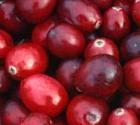
|

Cranberries are a group of evergreen dwarf shrubs or trailing vines in the genus Vaccinium subgenus Oxycoccos, or in some treatm
Closely resembling the blueberry, cranberries are tart red berries that are eaten, made into decorations, and also used medicinally. In the U.S., cranberries are cultivated primarily in two states: Washington and Massachusetts, which is actually the home of Ocean Spray brand Cranberry juice . The medicinal properties of cranberries can be obtained both from the whole fruit and from cranberry extracts.
Cranberry juice is mighty tasty, and when used as a trimming for the Thanksgiving turkey, it definitely lends a certain level of holiday cheer to the plate. But its not just regarded as fruit anymore. Cranberry actually has the ability to stop a Urinary Tract Infection (UTI) dead in its tracks, which is great news to the nearly one-third of women who will experience this type of bacterial infection at least once in their lives.
First discovered in the 1920s, eating cranberries actually makes the urine more acidic, converting the usual uric acid form of urine into Hippuric acid, a stronger acid. This form of acid was found to have a strong antibacterial effect on the urinary tract. The strong acid makes an inhospitable environment for bacteria by not allowing bacteria to stick to the walls of the urinary tract. Bacteria need a foothold to be able to replicate and when they do not find one, they are simply flushed out of the body.
Using cranberry also has another great effect on the urine: it acts as a deodorizer. This may be very helpful to those who suffer from incontinence, which can result in strong, odorous, and sometimes embarrassing urine. Also, cranberry is a good source of vitamin C.
Cranberry can be useful for both the prevention and treatment of UTIs, either in supplement or juice form. However, it is important to note that persistent UTIs should be treated immediately with antibiotics and monitored by a physician. There is no RDA for cranberry extract, as it is not an essential nutrient. Doses usually range from 400-800 mg/day or 8-16 fluid ounces of juice per day. When choosing a juice, try to find an undiluted, unsweetened source, which can usually be found in any health food store.
Cranberry cocktail drinks that are available at the regular supermarket are only half-cranberry and the rest is water and juice. You would have to drink twice the recommended amount if you choose cranberry cocktail, so buy the pure form and just add sweetener at home.
Specification
| Product name |
Cranberry extract |
| Test Items |
Specifications |
| Appearance |
Violet fine powder |
| Anthocyanidins (UV) |
1.0% or5.0% or 10% Min |
| Particle size |
98% pass 80mesh |
| Bulk density |
40-65g/100ml |
| Loss on drying |
5.0% Max |
| Residue on ignition |
5.0% Max |
| Heavy metals |
10ppm Max |
| Total Plate Count |
1000cfu/g Max |
| Mold & yeast |
100cfu/g Max |
| E.Coli |
Negative |
| Salmonella |
Negative |
Packing: 25Kgs/drum
Storage: Stored in a dry and cool place, keep away from strong light and heat.
Shelf life: Two years when stored properly in a well-closed container.
| Type: Sweeteners |